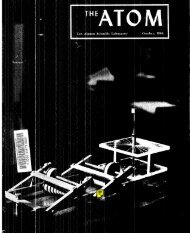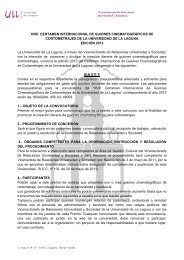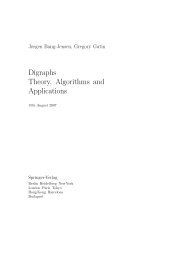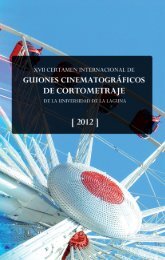You also want an ePaper? Increase the reach of your titles
YUMPU automatically turns print PDFs into web optimized ePapers that Google loves.
How much will the temperature increase<br />
when the pressure increases<br />
to 1.01 atm?<br />
Surprisingly, it is the Carnot<br />
theorem that helps us calculate the<br />
shift in the meltingpoint of ice. Yes!<br />
The very theorem that deals with<br />
the maximum efficiency of heat engines.<br />
"What has this to do with the<br />
melting point of ice?" you may ask.<br />
The point is, Nicolas Camot proved<br />
that the maximum efficiency of a<br />
cyclic heat engine of any design does<br />
not depend on what this engine uses<br />
as its working substance-an ideal<br />
gas, melting ice, or a soapy film.<br />
Only one condition must be met:<br />
the engine must acquire heat at a<br />
temperature T, and release it at a<br />
temperature T, (there must be no<br />
heat exchange during the intermediate<br />
steps). The efficiency of such an<br />
ideal engine (known as a Carnot engine)<br />
is attained by a slow, reversible<br />
process and, regardless of the working<br />
substance used, equals<br />
W 7,.7"<br />
n_ _= _;, (1)<br />
qir<br />
where I4l is the work performed by<br />
the engine per cycle and Q, is the<br />
amount of heat obtained at the temperature<br />
7r.<br />
Let's consider our imaginary<br />
Carnot engine to be a vertical cylinder<br />
with a piston (fig. 1a). Inside the<br />
cylinder we put ice of massm under<br />
PressureP, = 1 atm and temPerature<br />
Figure 1<br />
I atm<br />
1.01 atm<br />
b<br />
TT<br />
d<br />
0'C (71 :273K\. Thepressureis stabilized<br />
by a weight set on the piston.<br />
To underscore the state of equilibrium<br />
between the water and the ice,<br />
the figure shows a small amount of<br />
water at the corner of the cylinder.<br />
Now let's describe, step by step/<br />
what goes on in this kind of Carnot<br />
engine during one complete cycle.<br />
1. Let's set the cylinder on a thermal<br />
reservoir at a constant temperature<br />
7, and transmit heat energy Q,<br />
= Lm to the system necessary to<br />
melt all the ice (I is the latent heat<br />
of fusion). As a result, the piston<br />
sinks a little (fig. 1b), because the<br />
volume of ice Vi: mlpi is larger<br />
than that of water V* = m/p*. This<br />
melting stage is represented by the<br />
line 1-2 on the graph, where the coordinates<br />
are pressure P and volume<br />
v (fig.2l.<br />
2. Now we take the cylinder away<br />
from the thermal reservoir, isolate it<br />
thermally (fig. 1c), and then increase<br />
the pressure very slowly until it is<br />
equal to P, + LP: 1.01 atm. (This<br />
can be done by pouring sand slowiy<br />
onto the piston.) This will result in<br />
a decrease in the temperature down<br />
toTr=Tr-LT, which is equal to the<br />
melting point of ice at apressure of<br />
1.01 atm.<br />
3. Now we put the cylinder on a<br />
thermal reservoir at a temperature ?,<br />
and remove heat until the water<br />
freezes again (fig. 1d). In figure 2 this<br />
stage is shown by the line 3-4.<br />
4. All that's left is to thermally<br />
T<br />
water<br />
rt Aa<br />
TA<br />
ice<br />
le,<br />
r1*Ar I a<br />
Tt- Yo,<br />
^T<br />
1 atm<br />
1.01 a<br />
Figure 2<br />
isolate the cylinder and slowly remove<br />
all the sand from the piston.<br />
This brings us back to the initial<br />
state.<br />
Now let's do some calculations.<br />
The work performed during the<br />
cycle can be found from the graph<br />
-<br />
it's equal to the area outlined by the<br />
cycle:<br />
(*<br />
-)<br />
[Pi P* )<br />
w = LP(vi - y,)= oPl "'- "'<br />
l.<br />
The amount of heat obtained from<br />
the heater is<br />
Qt = Lm'<br />
Hence, from the Carnot theorem (1)<br />
we get<br />
^P(r- -'l<br />
Ip, p* )<br />
Lm<br />
AT<br />
or, for any arbttrary temperature 7t<br />
:7,<br />
' r)<br />
^r = ^P!l L.<br />
This is known as the Clapeyron-<br />
Clausius equation. Substituting numerical<br />
data in this equation gives<br />
us A? = 9.2. l}-s K forM = 0.01 atm.<br />
The effect is clearly very small. To<br />
change the melting point by say, I K,<br />
we need apressure of about 133 atm.<br />
Now we can get back to our skating.<br />
The pressure produced by an ice<br />
skater can be estimated as P : mglS<br />
600 N/2 cm2:30 atm. The corresponding<br />
shift in the meltingpoint of<br />
=<br />
ice is about 0.3 K, which is surely too<br />
little on a cold winter's day. So the<br />
"l\aive" little kid was right after aII:<br />
TT<br />
28<br />
JUIY/AUOlJST Igg4








